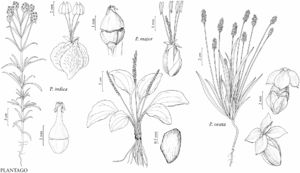Plantago indica
Syst. Nat., ed. 10, 2: 896. 1759, legitimacy of.
Annuals; roots taproots, slender. Stems 100–350 mm, freely branched. Leaves cauline, opposite, 60–80 × 1–3 mm; blade linear to linear-lanceolate, margins entire or toothed, veins conspicuous or not, surfaces hairy. Scapes 100–650 mm, hairy. Spikes greenish or brownish, (50–)150–250 mm, densely flowered, eglandular; bracts proximal strongly differing from distal, ovate, 2–5(–7) mm, length 1–1.5 times sepals, proximal bracts: apex acute. Flowers: sepals 2–3 mm; corolla radially symmetric, lobes reflexed, 2–4 mm, base obtuse; stamens 4. Seeds 2, 2–2.5 mm. 2n = 12.
Phenology: Flowering late summer–fall.
Habitat: Roadsides, railroads, sandy shorelines.
Elevation: 0–200 m.
Distribution
B.C., Man., Ont., Que., Calif., Conn., Del., Ill., Ind., Iowa, Maine, Mass., Mich., Minn., Mo., N.H., N.J., N.Y., N.C., Ohio, Oreg., Pa., Vt., Va., Wash., Wis., Eurasia.
Discussion
While considering the proposal made by W. L. Applequist (2006) to reject Plantago psyllium, the Nomenclature Committee for Vascular Plants also decided that P. indica is a legitimate name (R. K. Brummitt 2009). A. B. Doweld and A. Shipunov (2017) published a proposal to reject P. indica in favor of P. arenaria. That proposal awaits a decision by that committee.
Selected References
None.
